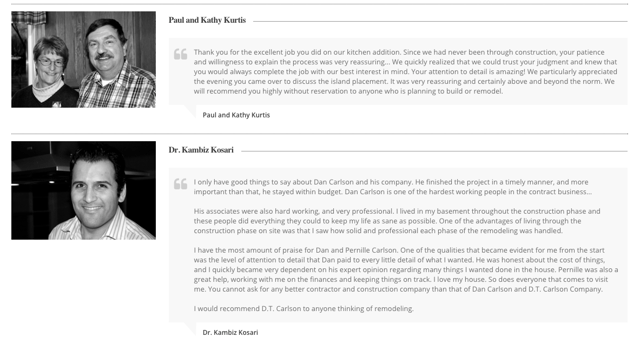4 Tips for Using Testimonials on Your Website

Testimonials from delighted customers can be used in a variety of ways, but many residential builders and remodelers fail to utilize them to their full potential. Are they hidden away on your website, simply listed on a separate page? If so, do you really think visitors to your site are seeking testimonials out on their own? Probably not. That type of search behavior is typically related to third-party reviews found on Google, Yelp, or Houzz.
To get more eyes on valuable testimonials for your business, give them a purpose, display them in creative ways, and use storytelling to help potential customers move forward in the buying process.
Tips for using testimonials on your website:
1. Use testimonials throughout your site.
Dedicated testimonial pages have become the standard for businesses today, but savvy home builders and remodelers are also using their best testimonials in more prominent locations throughout their site to prompt action on pages where visitors are making decisions. Use your testimonials on landing pages for offers (say, on the sidebar next to a form), on your blog template under the subscribe button, or even on the homepage, such as the scrolling testimonial footer in the example below. Testimonials are an effective way to provide social proof and to address common concerns and questions customers may have during the buying process.
Example: Amaris Custom Homes

2. Find a creative way to display testimonials.
Make your testimonials pop off the page with a creative and user-friendly design. In the example below, the testimonials are arranged in a card design using different brand colors. Such an approach breaks from the traditional testimonial list page that is often overlooked by visitors. These card designs could be replicated throughout the site and even repurposed for print materials or social media posts.
Example: John Kraemer & Sons

3. Produce video testimonials.
Video testimonials are highly effective pieces of marketing content that can also be used to create more elaborate case studies for your online portfolio. Although they may take a bit more time and effort to develop, a few strong video testimonials will attract more attention than a long list of written testimonials. In the example below, notice the how the content of the testimonial reinforces the Phase Remodeling Program call-to-action in the sidebar.
Example: J.W. Williams Construction

4. Tell a story using testimonials.
Buying a new home or remodeling an existing home is an emotional process for people. Highlight your customers' personal stories rather than vague descriptions of your service. Encourage your customers to describe their concerns prior to the project and how your company addressed those concerns with specific actions throughout the process. The following example effectively combines storytelling and imagery to humanize each testimonial within a clean, consistent design.
Example: D.T. Carlson Co.

Builders and remodelers are busy working on projects. We get that. However, the next time you receive a testimonial from a happy customer, think about how the message can be used to enhance online and offline marketing efforts. Testimonials can be used to trigger action, help generate more leads, and provide social proof to substantiate your claims for buyers in each stage of the process.

